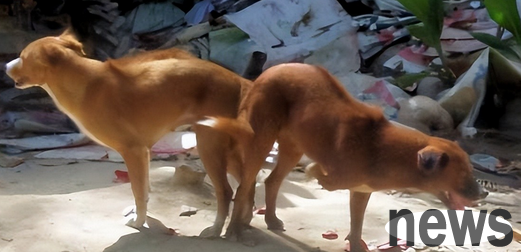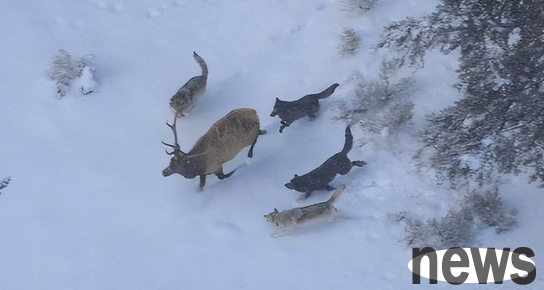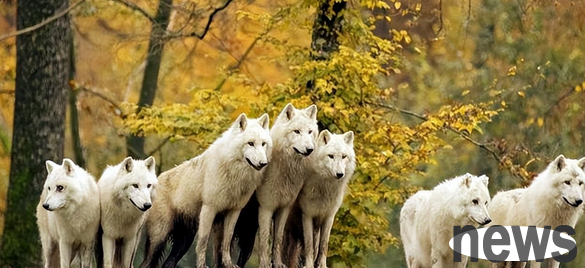In rural areas or urban villages, we often see two dogs connected butt-to-butt, and they cannot be separated no matter how much they are chased or beaten.
In fact, they are preparing to breed the next generation. It is best not to disturb them. If you are not careful, it may cause injury to both parties, especially the male. In severe cases, you may lose the ability to reproduce.

So, many people don’t understand why dogs have such a weird way of mating. Isn’t this dangerous? If a natural enemy encountered them, wouldn't they both be killed?
In fact, this strange mating method is not unique to dogs, but is a characteristic of the entire canine family.
There are 13 genera and 36 species in the Canidae family. The animals we can imagine that look similar to dogs are basically canids, such as jackals, wolves, foxes, wild dogs, war mastiffs, etc. Their matings all have the same characteristics - locking, or locking.
Why do dogs have such strange mating methods? We have to start with their evolutionary history. To put it bluntly, this is all inherited from their common ancestors.
Differentiation of Canidae and Felines
The ancestor of canids is a carnivore that lived in the forest, the Dentodon, which is also the ancestor of cats.
At the end of the Early Tertiary Period (65 million to 23.3 million years ago), dogs and cats were still close relatives, with similar body shapes and living habits.
About 35 million years ago, the canidae began to differentiate. By the late Tertiary Period (23.3-1.64 million years ago), the canidae and cats had completely separated and chose completely different development directions.
The canids expanded outside the forest, and they began to evolve physical characteristics that were more suitable for life outside the forest - their necks became longer to help them observe the distance, their limbs became longer to help them run long distances, and their sharp claw tips began to degenerate because they no longer climbed trees. In addition, in order to better hunt for food, they chose to live in groups and stay in groups for warmth.
Cats almost always win with explosive power, approaching quietly, making sudden sneak attacks, and either succeed in hunting or give up. They cannot maintain speed for a long time, but canines are completely different. They mainly win with endurance. If sneak attacks are not possible, they will continue to pursue. They even work within the group to cooperate, some pursue and some intercept, which greatly improves the success rate of hunting.

The mating methods of dogs and cats
We can imagine that when cats and dogs first split into two, their mating methods should be similar. However, they later took different paths. Cats chose the method of multiple seconds of shooting, while dogs chose the method of single knotting.
Why does this difference occur? This has to start with their later living habits. In fact, these two methods are very beneficial to them, that is, they meet their own needs.
For cats, they mainly live alone, so "second shot" is undoubtedly the safest. Most cats mate for a short time, and the shortest is only a few seconds. For example, tigers and lions can mate in a few seconds or more than ten seconds. However, in order to increase the probability of successful reproduction, the number of times must be increased. For example, lions and tigers mate 20-40 times or more every day during their mating season.
Canines are different. Their high heads and ears can detect sounds from far away, and their gregarious lifestyle also helps them better guard against natural enemies. Therefore, the mating environment of canines is much safer than that of cats.

If canines adopt the cat's "second-shot" mating method, they will undoubtedly be eliminated by the lock-knot mating method of other similar species, because its success rate is too low. The lock-knot mating method can occupy the pit for a long time, and it is in place at once, completely giving no chance to the "second-shot" kind. Even if the "second-shoot" ones have better genes, stronger speed and strength, there is no guarantee that they will not fall into the trap of mating.
Therefore, "knotting", a somewhat dangerous mating method, not only was not eliminated in the relatively safe environment of group living, but showed unprecedented superiority, and finally eliminated all "instant shooters".
Why is it unique to the canine family?
Some people may ask: There are so many social animals, why can dogs evolve this way?
I think there may be two reasons. First, among animals that live in groups, there are not many animals that can guarantee a high degree of safety when mating. Herbivores have too many natural enemies and must be ready to escape at any time. Among carnivores on land, the ones with fewer natural enemies are mainly cats and canines.
The second reason is that evolution does not have a specific direction. Evolution is actually a combination of necessity and contingency. Inevitability means that the fittest survive, and the unfit perish. Contingency means that there are many suitable ways, and God does not know which way will evolve - there is no best way, only the way that suits you best.
Perhaps, the canine family also had a "second-shot" mating method similar to that of cats at first, but later, a male canine underwent a genetic mutation and evolved a special structure of reproductive organs that can be "locked". Unexpectedly, this mutated reproductive organ became more and more dominant in the entire population, and more and more offspring had the "locking" function. Gradually, the proportion of genes for the "second-shot" mating method became smaller and smaller, and finally disappeared because it was difficult to reproduce the next generation.
This genetically mutated male canine is an accident of evolution. It is the male ancestor of all modern canines. Without its appearance, canines may still retain the mating methods of cats.
The magical knot
So, what exactly is the canine knot?
It turns out that the penis of male canines has evolved a very strange shape-two spherical enlargements have evolved on the front end of the penis..
During the mating process, these two swellings will become filled with blood and swell into a shape similar to a lollipop, and the relevant muscles of the female will also contract. As a result, the swellings will be stuck, resulting in a locking phenomenon.

In fact, canines also "shoot in seconds", which is no different from cats. The only difference is that after the canine has transferred its own genetic material, it must continue to occupy this position to eliminate the interference of other males' genetic material.
Their effective mating actually lasts only a few minutes, but the knot can last for half an hour, or even an hour or two. During this period of knotting, male canines will also excrete genetic material, but mainly prostate secretions that do not contain genetic material. It can be seen that even if the knot is not tied, mating can still be successful.
Therefore, from the perspective of mating alone, the canine knot is simply a waste of time, and it is disgusting that "occupying the latrine and not pooping", but people just occupy the latrine and prevent other dogs from "pooping" - and this is their advantage. Occupying the latrine for an hour or two is enough to ensure the combination of sperm and egg cells, so that other males can only stare at it.
Wealth is sought in danger
The dogs we see today, whether they are strong and fierce mastiffs, tall and mighty Great Danes, or Chihuahuas that are only 20 centimeters in length, are actually descendants of modern canine gray wolves domesticated by humans around 16,000 years ago. Therefore, all dogs have inherited the "knot-locking" function of their ancestors.
The locking function can maintain advantages when living in groups in nature. After gray wolves were domesticated into dogs, their advantages became more obvious.
Under the protection of humans, dogs have become safer than ever. Even if they are tethered for a day, it is difficult to encounter danger, unless the danger comes from their owners, humans.
Therefore, it can be seen that it is reasonable to "seek wealth and wealth through danger". The ancestors of dogs, dogs, gave up safety and exchanged a little risk for the absolute advantage of reproduction. In one word - worth it!
Article source: Universe Exploration-Today’s Toutiao
